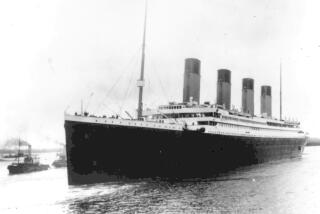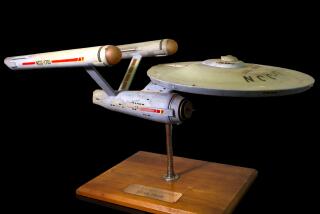Titanic artifacts up for auction: Casual buyers need not inquire
- Share via
Reporting from New York — For sale: one puppy. Appraised value: about $189 million.
OK, it’s not a puppy, but if you’ve had one, you have an idea of the all-consuming commitment of owning the treasures from the Titanic, auctioneer Arlan Ettinger said Thursday as he warned off casual buyers tempted to bid on the collection when it goes on sale in April.
For one thing, the items — more than 5,000 of them — must be sold in bulk, Ettinger said at a news conference announcing the auction, held just up the Hudson River from where the Titanic was due to dock in April 1912. That means the gold coins, the perfectly preserved demitasses, and the man’s vest with buttons still attached will come with a 17-ton hulk of hull and no shortage of other items better suited for a shipyard than a collector’s coffee table.
And whoever buys the trove takes on the task of being steward over the collection and the submerged wreckage, responsible for keeping some of the collection on public display at any given time and preserving it, and the ship’s remains, for future generations.
“It’s like getting a puppy. When you bring it home, you don’t think of all the responsibilities and the time and investment that will be required. You just know you’ll have this great companion,” said Ettinger, president of Guernsey’s Auctioneers & Brokers. “But it takes great care.”
That’s one reason that Premier Exhibitions Inc. is happy to pass on the job to someone else. Premier Exhibitions spokesman Brian Wainger said the timing was perfect, given the upcoming centennial of the ship’s sinking. This year also marks the 25th anniversary of the recovery of the first artifacts from the seafloor.
“There’s a beautiful symmetry in the timing. Now is the perfect time to pass off the collection,” Wainger said.
As countless films — including a Nazi propaganda film from 1943 — books, and deep-sea expeditions have recalled, the Titanic was the world’s largest and most luxurious ship when it set sail from Southampton, England, on April 10, 1912, for New York. It hit an iceberg in the North Atlantic on the night of April 14, and early the next morning the purportedly unsinkable Titanic sank.
Of the 2,228 people on board, more than 1,500 died. The last survivor, Millvina Dean, who was a baby put into a lifeboat as the Titanic sank, died in 2009 at the age of 97, taking with her the ship’s last living legacy and heightening the pressure to preserve the artifacts and wreckage that remain.
“What it means to be steward of this wreck site is to save history,” said Wainger as some of the small items to be sold off sat in display cases, looking remarkably fresh despite their turbulent past.
A $1 silver certificate lay flat, without rips and looking as if it had just been pulled from a damp wallet. A wool vest pulled from the suitcase of one William Henry Allen appeared pressed and ready to wear. Spectacles were unscathed. Two drinking cups — a delicate demitasse for upper-crust passengers and a heavy piece of crockery for the third-class dining room where Leonardo DiCaprio’s character in the 1997 blockbuster “Titanic” would have eaten — had survived without chips or cracks.
This won’t be the first auction of Titanic memorabilia, but it will be the first of items taken directly from the wreckage site. Previous sales featured items such as a recovered deck chair, letters written by survivors, and the advertising brochures that White Star Line produced in advance of Titanic’s first, doomed voyage.
None of those sales came close to what the April auction could fetch, if a 2007 court-ordered appraisal holds true. It set the value of the artifacts and some intellectual property rights of RMS Titanic Inc. — a division of Premier Exhibitions that has overseen salvage and research expeditions to the wreck since 1987 — at $189 million. But Ettinger said the lack of precedent makes it impossible to guess what the winning bid will be.
“It’s easy to appraise certain objects where there’s a precedent,” he said, citing as an example a Picasso painting that has been repeatedly sold at auction. “But not one object that was on the ship when it went down has ever been sold.”
Already, he said, Guernsey’s had received phone calls from “serious-sounding parties.” Both Ettinger and Wainger said the most suitable buyer would be an individual or private entity, because of the time and expense of maintaining the collection and overseeing the wreckage as it is slowly devoured by iron-eating microbes on the seafloor.
Over time, Wainger acknowledged that the cost has proved difficult for Premier Exhibitions, a publicly held company with a responsibility to its shareholders.
“This company has essentially turned itself into a traveling museum and a conservation lab,” Wainger said.
“It’s not just the money,” he added. “It’s the man-hours. It’s the risking of lives.”
One man was lost at sea during a 2010 expedition to map the wreckage, which wasn’t discovered until 1985 after many failed attempts. Two years later, the first expeditions began to survey the wreckage, using submersibles to carry scientists, marine archaeologists, engineers and others.
One of the researchers was P.H. Nargeolet, director of underwater research at Premier Exhibitions, who on Thursday described the drama of his first descent 2 1/2 miles below the sea surface.
To save battery power, the submersible lights were not turned on until it came to rest in the bow section of the Titanic. Suddenly, Nargeolet said, the scientists who had been chatting throughout the descent fell silent as they surveyed the rusted but recognizable shell of the ship.
“Nobody was talking for at least 10 minutes,” he said.



